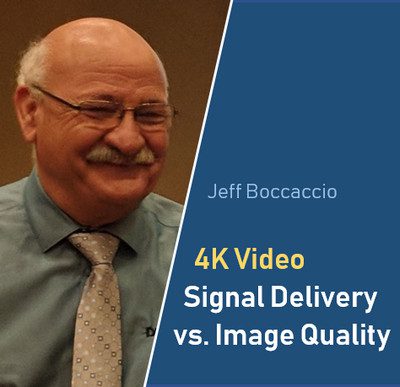ESTABLISHING A PREDICTABLE HDMI transmission line, for long and short runs, has always been the challenge due to its dependability issues (hence, DPL’s existence). Products have evolved from Cat-5 “baluns” to HDBaseT extenders, to IP-based network traffic, to Software Defined Video over Ethernet (SDVoE), and yes, even to RF.
Early Cat-5 products consisted of both single and double pairs of Category wire with the addition of some electronic equalization products to compensate for insertion loss. Converters like HDBaseT, or HDMI to IP and RF started using transmission schemes such as PAM, network protocols, VSB, QAM, and cable EQ.
Then came 4K and HDMI Rev 2.0 where the bandwidth basically doubled to 18Gbps. This caused even more problems; these 10.2Gbps extenders lost their usefulness once Rev 2.0 became the norm.
To add insult to injury, the mainstream cable firms were having their own active extender issues delivering 18Gbps reliably past 7 meters. They had multiple setbacks with failures, recalls, inefficient designs, and power issues. It wreaked havoc on the perception and use of HDMI.
HDMI 2.0 Brings 4K/60 over 10.2Gbps
But there was one part of the HDMI Rev 2.0 revision that could provide some relief.
Companies found that the new spec offered a feature set that could transfer a 4K/60 video format while still only using a 10.2Gbps data rate. It did this by reducing color performance — a form of color information compression. Your eye is less sensitive to loss of color information than it is to loss of luminosity levels.
This allowed all the 10.2Gbps products to continue as before with their features, their benefits, and their dependability — at least for a while.
It wasn’t until just recently that the requirement for a true 18Gbps transmission link really hit the streets, mostly because of the proliferation of affordable UHD 4K TVs and associated 4K source material. This soft 4K/60 introduction allowed time for companies to react and come in with some kind of long-distance alternative.
It became evident that fiber was going to be a critical player and, although the costs were a bit higher if made properly, it would be a good alternative to copper for pure 18Gbps long-distance transmissions.
Some products were developed using all fiber while others were constructed in a hybrid type of design encompassing both fiber (on the higher-speed TMDS lines) and copper (on the lower-speed, power and handshaking lines).
4K/60 over Existing Cables: Display Stream Compression
On the extender front, companies and integrators were looking for ways to deliver 4K/60 transmissions over their existing infrastructures. The only way out was to either design higher bandwidth extenders or offer some kind of additional compression scheme.
The leading algorithms like MPEG, H.264, and JPEG-2000 performed well, but all suffered from higher costs and lower picture quality with visual distortions like banding and motion artifacts.
In 2014, VESA introduced a new compression standard known as Display Stream Compression (DSC). The mission was to produce an improved compression scheme that supports RGB, YCrCb, 4:2:2, or 4:4:4, with 8-, 10- and 12-bit color depths.
Also built into this specification was an additional feature known as Index Color History (ICH), potentially improving some of the limitations inherent in previous systems. With this and other processes, it was claimed to be a far better compression scheme and brought with it new terms like Visually Lossless Compression (VLC).
The DisplayPort community hopped on board the DSC bandwagon; HDMI, not so much — yet (stay tuned for Rev 2.1).
Compromises: Quality vs. Compression
All these new alternatives now provide multiple choices for integrators.
On the image quality side of the equation, there are both passive and active copper HDMI cables in addition to a growing number of fiber optic-based solutions.
On the compression side, we’ve seen some HDBaseT vendors leveraging DSC as a way to claim they can support 2160p/60 with high dynamic range (HDR), wide color gamut (WCG), and 4:4:4 color rendering.
Keep in mind, however, that these schemes still add compression to the signal, which always relies on some level of data loss and thrown-away bits.
It also induces some level of delay in the signal chain as more and more bits have to be processed. It comes down to just how much of a “visually lossless” reduction in quality you are willing to accept.







